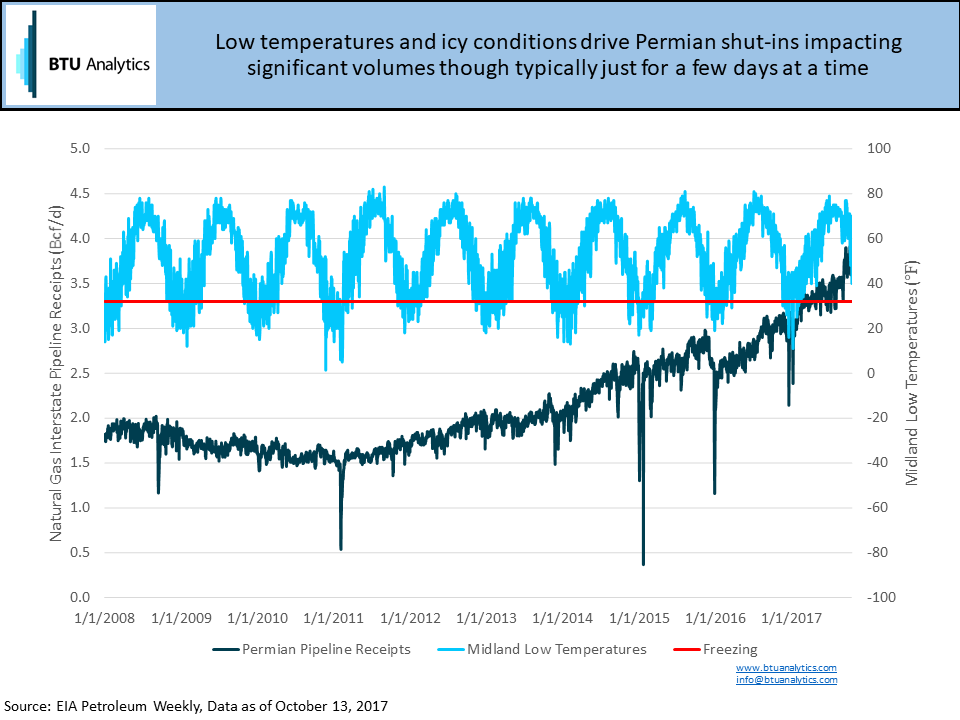As temperatures in the Western US begin to show signs of cooling, US oil production continues to heat up as it recovers from hurricane impacts. However, cold weather induced supply disruptions are just around the corner as winter approaches. Permian freeze offs will continue to add to the market’s questions on the pace of US supply growth and the re-balancing of the 2018 oil market.
The graph below shows natural gas pipeline receipts on the interstate pipelines originating in the Permian basin versus Midland, Texas low temperatures.

As overnight lows drop in West Texas below 32 degrees, the amount of gas hitting the interstate pipelines begins to drop off. In part, this is due to demand in the intrastate market absorbing a portion of the supply before it ever reaches the interstate pipeline network. But as temperatures plummet below freezing, bigger disruptions in gas and subsequently oil volumes become more evident in the data, with the worst Permian basin freeze offs occurring in January and December 2015.
Production interruptions due to freezing temperatures in the Permian occur for two primary reasons. The first reason is that as the air temperatures fall, natural gas liquids and water that would otherwise normally be a vapor in gathering lines condenses. The condensed liquids clog up flow lines and restrict production across the system. Days with high variations in temperatures may see gathering pipelines experience freeze offs overnight only to have the afternoon temperatures warm up enough to naturally unclog the lines allowing flows to resume without sending workers into the field. However, extended periods of cold can result in more material freezing events which require time and effort to restore normal operations at the wellhead.
The second driver for production interruptions due to freezing temperatures is snow and ice on the roads. Significant volumes of crude in the Permian basin have historically been trucked from the wellhead to market. As cold weather strikes and brings ice storms to the region, truck traffic can decline dramatically. In addition to existing production, drilling and completion operations also see delays impacting the pace of new supply additions. So as winter approaches, how much impact might we expect from freezing temperatures in the Permian?

The table above reviews the impacts of freeze off events from the monthly state production data and allows us to remove the noise of volumes serving the intrastate market. Every winter experiences some level of freeze off event where production declines relative to the start of winter, though the magnitude and longevity of supply declines can vary significantly from year to year. In percentage terms, the Permian freeze offs in February 2011 knocked out 10% of monthly supply of natural gas and 8% of oil and in January 2015 outright volumes fell by more than 0.5 Bcf/d of natural gas and 100 Mb/d of oil. However, last winter oil volumes grew despite natural gas volumes declining each month between Nov. 2016 and Jan. 2017. This likely occurred due to older wells with higher gas to oil ratios being more impacted than newer wells with lower gas to oil ratios.

The graph above highlights the risks to Permian volumes based on BTU Analytics’ Upstream Outlook forecasts for Permian natural gas and crude oil volumes for January 2018. Should winter of 2017-2018 experience an average freeze off, natural gas volumes would decline by nearly 0.5 Bc/d and nearly 75 Mb/d of crude oil would be taken offline. Should a colder and icier winter hit the Permian basin like in February 2011, at least 0.9 Bcf/d could be disrupted over the course of the month (a total of 27.5 Bcf shut-in) and nearly 200 Mb/d of oil or 6.4 million barrels of crude. While official start to winter is still two months away, the risk of weather based supply disruptions remains due to Permian freeze offs.









